Barbara Warren's Blog
December 31, 2016
Reflections.
 All my traditions surrounding Christmas from the past seven years have been shattered this year.
All my traditions surrounding Christmas from the past seven years have been shattered this year.Which sent me on a path of reflection.
Think back to this time last year and the controversy surrounding refugees in Canada.
No country seems devoid of conflicts...Mexico El Chapo. Refugees arriving by boat, and putting Europe in turmoil, can you forget those images? Terrorist attacks. Brexit, Fort McMurray fires. Trump!!!
So out of the shattering of past traditions and the sadness that is attached by not being together, come new traditions and reflection. I look to tonight as a new beginning and a closing of a very happy past. My glass will be raised to all events and friends who have helped to shape and make me the person I have become today. Thank you.
To those that I will share this night with I will look forward to our new friendship with joy and the openness of what lessons I have yet to learn from each of you.
Out of close relationships that sometimes change for no apparent reason, one has to rejoice with the memories of all the good times spent together. Very few friendships last a lifetime, think about it, especially if like me you don't even live in your birth country.
I am so happy when I see my own daughters with friends that they have had most of their lives as they have only lived in one country. But at the same time I celebrate in the friendships that I still have that are 45 to nearly 54 years... in fact looking forward to catching up with one of those long friendships in January, when they come for a holiday here in Mexico.
So reflecting on the past exciting year that I have had, and looking forward to 2017 and whatever it holds for me. Remembering to be kind to myself and not allow that inner critic to take over! (Thank you Thérèse your book, A Kinder Voice is amazing...)
When you are peace with yourself and don't live in the past, know how to forgive and forget, out of any ruins comes hope and new beginnings.
Happy New Year.
Published on December 31, 2016 10:12
November 20, 2016
What Love Can Do..
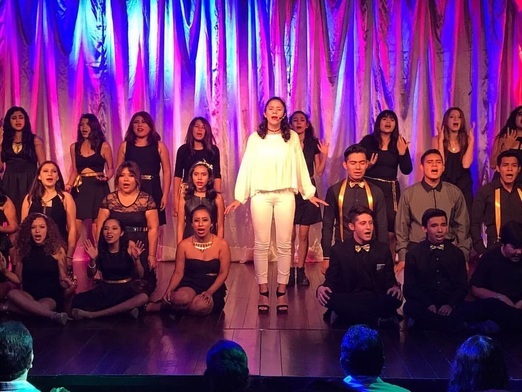 We first became involved with Alas Escuela de Canto nearly three years ago.
We first became involved with Alas Escuela de Canto nearly three years ago.A young woman Kharla, who had a dream of starting a school of singing for young people who were troubled in some way. They would have somewhere safe to come to and have fun singing. That is how we became involved as she needed funds to support these needy children.
That was then, but it has morphed into something much bigger.
Besides families in stress, more affluent families could see, through the free performances that Kharla did weekly, what was happening to these students and their attitudes and the benefits from Kharla's love.
These families wanted to have their children doing the same thing and wanted to pay Kharla to take them. Therein was the challenge.
Through Kharla's love, now everyone benefits. Yes, everyone including parents.
The 2015 concert was the beginning of something new. At one point towards the end of the performance Kharla had gathered the students on the stage with their backs to the audience for a slide show of the students from the time they were babies, of course the students were totally engrossed in this. Many with their arms wrapped around each other.
Silently, like a cool breeze wafting in the theatre , with little movement people stood in the isle each taking a stair for their own, standing like sentinels.
As the slide show came to end Kharla who had been sitting behind her students at stage front and center , slowly rose as the house and stage lights burst on, pointing at the audience. As the music gently started and angelic voices began to sing, the children turned to see their parents singing to them.
Emotional, you can't imagine. Children whose parents had abused them in some way, maybe, or not given them support when they needed it, poor parents who have little or nothing ,standing within the parents who had everything to offer their children. Singing doing what their children love.
Even a year later this stirs my emotions.
Then we come to last nights concert where not only did the young students perform , but parents too. I am not sure who had the most fun on stage.
Maybe Kharla it time to offer a class to your ' snowbirds .'
Published on November 20, 2016 08:36
November 12, 2016
These Feet Were Made For Walking...
 People are funny...especially with gadgets... for example the electronic step counter!
People are funny...especially with gadgets... for example the electronic step counter!I have a younger friend here, who goes everywhere by car, who wears one of these gadgets (?cost..$150? ) She covers the gadget with gold or silver bracelets. Doesn't like to even walk a couple of blocks.
The other day we were having coffee,when she talked about this gadget saying the goal was 10000 steps a day. Which in the last eight months she has never reached! What do you usually do in a day I asked innocently? The most was around 3000, which was exhausting, was her laughing reply. As I try four or five times a week to walk the Malecon, I wonder how many steps that is, plus the four block climb to the 92 stairs to reach our home!
Last night we ended up for a coffee and dessert in the local coffee shop, we started on our own and ended up with eight of us gathered around our small table.
I watched one of our older residents from our condo come in, and got up to welcome her back.
When did you arrive? Niss , slim and white haired smiled and said couple of days ago as we held hands pleased to see each other for yet another year. How did you get here referring to the coffee shop. She told me she had walked the Malecon after getting to the restaurant by taxi , taking the friend with her to celebrate her 94 birthday. I smiled as she shook her head as she confided that the Malecon was the only place she could walk these days as the cobblestones played havoc with her walking stick! Ninety four young...and not wearing a gadget!
Me I don't wear a gadget, not even one that tells me to get up as I have been sitting for too long!
But I do walk everywhere that is possible managing the other day to walk to a shopping centre that is 4.4 km away, just to go to the bank!
Yep, I love Mexico because our whole living style is different and these feet were made for walking.
Published on November 12, 2016 13:14
September 30, 2016
Interesting
Published on September 30, 2016 09:28
September 19, 2016
Jaqu0 Magazine Review
http://jaquo.com/http://jaquo.com/eve...
Everlasting Lies: An intriguing novel.Author Barbara Warren has created a novel that will captivate you — and leave you wanting to hear more from her. Set in the early part of the twentieth century, the book takes us through the life of one man and his family as events take him from the north of England, to the horrors of France in the First World War and eventually to an exotic lifestyle in India.Charles disowns his parents and siblings when still a young man; in fact, Charles isn’t really his name. Having cut himself of from his wealthy family he creates a completely new identity for himself. And in this new life, he soon meets the woman (or girl rather, she is only fourteen) of his dreams and their relationship soon develops.Edina, though only young, is completely willing to embark upon a sexual relationship with young Charles who is lodging with her family and, almost inevitably, she becomes pregnant.What she doesn’t realise is that Charles has a distinct dark side. Although he agrees to marry Edina, she discovers that he has a totally controlling personality, he is extremely vengeful and treats his now-wife as his slave. What’s more, he often frequents prostitutes.When the First World War started in 1914 Charles enlisted – more to escape his boring job and his wife who now has two children. Edina, left to make a life for herself and her son and daughter, rekindled a relationship with Bill, a man she has known since they were both children.Charles heads out to France and when he returns on leave, he is surprised that his downtrodden wife is eager to make love. He does not realise that she is already a month pregnant by Bill…Potentially explosive situationEdina persuades Charles that he is the father of her third child but she desperately wants to get away from Charles to start a new life with Bill but Charles refuses to divorce her. He says that if she runs away he will hunt her down and make her pay. What will she do?A new life in India?Charles is sent to India after the war and lands a good job there. He wants Edina and the children to join him in his new life. Will she return to her domineering husband or remain with her beloved Bill? And if she chooses the latter, how will Charles exact his revenge?A new family saga to come?Read this book and you’ll really get to know these well-created characters and care about what happens to them in the future. (Even the despicable Charles). The story of Charles and Edina ends in 1920 and I sincerely hope that Barbara Warren is already writing a sequel – this is a family saga in the making. More please Ms Warren!A fictional family historyAn added bonus to this novel is its background. Ms Warren based the saga on mysterious elements in her own family history. Names have not been changed for the novel – Charles was her secretive grandfather who never spoke about his background other than to say that he had disowned his wealthy family.As she says herself ‘maybe somebody will know the whole truth’. If so, I hope this too becomes an equally fascinating truth. I highly recommend this novel.Criticisms?I rarely read a book without being critical and with this I have just one. Ms Warren was born and brought up in England but left for Canada in her early twenties. As someone who was born and brought up in the North of England, there are some language / dialect errors. But what a minor criticism from pedantic northerner! This will certainly not prevent you from enjoying this book.
Everlasting Lies: An intriguing novel.Author Barbara Warren has created a novel that will captivate you — and leave you wanting to hear more from her. Set in the early part of the twentieth century, the book takes us through the life of one man and his family as events take him from the north of England, to the horrors of France in the First World War and eventually to an exotic lifestyle in India.Charles disowns his parents and siblings when still a young man; in fact, Charles isn’t really his name. Having cut himself of from his wealthy family he creates a completely new identity for himself. And in this new life, he soon meets the woman (or girl rather, she is only fourteen) of his dreams and their relationship soon develops.Edina, though only young, is completely willing to embark upon a sexual relationship with young Charles who is lodging with her family and, almost inevitably, she becomes pregnant.What she doesn’t realise is that Charles has a distinct dark side. Although he agrees to marry Edina, she discovers that he has a totally controlling personality, he is extremely vengeful and treats his now-wife as his slave. What’s more, he often frequents prostitutes.When the First World War started in 1914 Charles enlisted – more to escape his boring job and his wife who now has two children. Edina, left to make a life for herself and her son and daughter, rekindled a relationship with Bill, a man she has known since they were both children.Charles heads out to France and when he returns on leave, he is surprised that his downtrodden wife is eager to make love. He does not realise that she is already a month pregnant by Bill…Potentially explosive situationEdina persuades Charles that he is the father of her third child but she desperately wants to get away from Charles to start a new life with Bill but Charles refuses to divorce her. He says that if she runs away he will hunt her down and make her pay. What will she do?A new life in India?Charles is sent to India after the war and lands a good job there. He wants Edina and the children to join him in his new life. Will she return to her domineering husband or remain with her beloved Bill? And if she chooses the latter, how will Charles exact his revenge?A new family saga to come?Read this book and you’ll really get to know these well-created characters and care about what happens to them in the future. (Even the despicable Charles). The story of Charles and Edina ends in 1920 and I sincerely hope that Barbara Warren is already writing a sequel – this is a family saga in the making. More please Ms Warren!A fictional family historyAn added bonus to this novel is its background. Ms Warren based the saga on mysterious elements in her own family history. Names have not been changed for the novel – Charles was her secretive grandfather who never spoke about his background other than to say that he had disowned his wealthy family.As she says herself ‘maybe somebody will know the whole truth’. If so, I hope this too becomes an equally fascinating truth. I highly recommend this novel.Criticisms?I rarely read a book without being critical and with this I have just one. Ms Warren was born and brought up in England but left for Canada in her early twenties. As someone who was born and brought up in the North of England, there are some language / dialect errors. But what a minor criticism from pedantic northerner! This will certainly not prevent you from enjoying this book.
Published on September 19, 2016 12:20
September 12, 2016
Virtual Book Tour...
Published on September 12, 2016 07:06
September 11, 2016
Do You Like Rodeos?
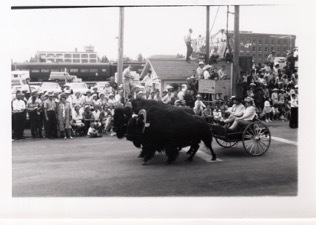
Tenderfeet { original
photos 1964!}
Tenderfeet { original
photos 1964!}
John and I arrived in Calgary, Alberta, in August 1963 fresh off the boat from England where we were born, educated and worked in London. We were 23 years old and very naïve about life in our new home in “the wild west “. Webster’s dictionary defines “a newcomer in a comparatively rough or newly settled region” as a tenderfoot. That was a good description of us!
Calgary, in 1963, had a population of less than 300,000 and was a very young as a city. Some of our friends were children of pioneers who had broken the original prairie sod or who had driven the first cattle herds into the tall grass meadows of the Rocky Mountain foothills. One of the ladies that John worked with that year was Helen Collins, whose mother had been the first white woman born in Calgary. It was a brand new country!
At that time, Calgary’s major claim to fame was to host “The Greatest Outdoor Show on Earth – The Calgary Stampede” every year in July and by the time that month came around in 1964 John and I were looking forward to enjoying the festivities.
The Stampede always starts with the Stampede Parade and, even then, thousands of Calgarians and visitors from around the world lined the streets to watch the show that lasted well over a couple of hours. The 1964 parade was led by the Grand Marshall, Lester B. Pearson, the Prime Minister of Canada, who was followed by military marching bands, cowboys just riding their horses or doing rope tricks, dozens of groups of Indians dressed in their headdresses of eagles’ feathers and robes of buckskin, bands from the Calgary School Patrol, floats pulled by horse and small tractors showing off the German, Polish, Scottish, Ukrainian, Chinese and other ethnic associations of southern Alberta and, behind each group of horses walked a half dozen men with brooms and shovels to pick up any “road apples” that may have been dropped along the way. We were wide-eyed as we watched all the activity.
However, before the parade, we had made our contribution too. For an hour or so before the parade had started and as the crowds were positioning their folding chairs or climbing up into the bleachers that lined the route, all of the two-dozen square-dance clubs in Calgary entertained the gathering crowds with their dancing skills. John and I had joined a club called the Richmond Revellers in the previous September and had danced with them a couple of times a week during the following nine months so on Parade Day I dressed in my bright yellow square-dance dress and Stetson hat and John wore his Stetson and checkered shirt ( I could never get him to wear jeans.) and we do-si-doed and allemande left with the other six people in our square. It was a blast and much applauded by the crowds!
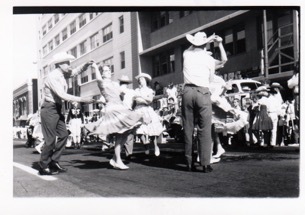
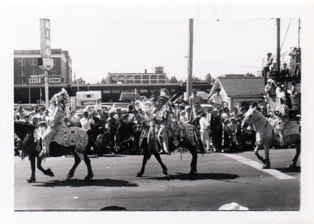 We both took the next day, Tuesday, off work, (although in Calgary then and now not much work gets done in Stampede Week) and spent the whole day “stampeding”. In the morning we went downtown, watched the Indians from the Sarcee, Stoney, Blackfoot and Peigans nations parade through the streets and then we joined a group of a hundred or so people square-dancing on 8th Avenue S.W. For lunch we grabbed a couple of burgers just inside the entrance to the Stampede Park and made our way to the infield events where the rodeo took place. John had managed to get us tickets to stand in the “photographers pit”, where we were joined by professional photographers from the Calgary Herald, the Albertan and from sports magazines from across Canada and the USA. The pit was dug an inch outside the wire of the infield and our heads were at ground level so if a bucking bronc or runaway steer charged towards us we had to make a split-second to decide whether to take the photo and risk a hoof in the head or to duck ignominiously until danger was further away. We had very little idea of the rules of the contests but our photographer friends helped us out during the gaps in the action. That afternoon we watched and photographed saddle bronc and bareback riding, calf roping, steer decorating, wild cow milking and brahma bull riding. All of them were hair-raising and suicidal to a tenderfoot like me but it was fantastically exciting.
We both took the next day, Tuesday, off work, (although in Calgary then and now not much work gets done in Stampede Week) and spent the whole day “stampeding”. In the morning we went downtown, watched the Indians from the Sarcee, Stoney, Blackfoot and Peigans nations parade through the streets and then we joined a group of a hundred or so people square-dancing on 8th Avenue S.W. For lunch we grabbed a couple of burgers just inside the entrance to the Stampede Park and made our way to the infield events where the rodeo took place. John had managed to get us tickets to stand in the “photographers pit”, where we were joined by professional photographers from the Calgary Herald, the Albertan and from sports magazines from across Canada and the USA. The pit was dug an inch outside the wire of the infield and our heads were at ground level so if a bucking bronc or runaway steer charged towards us we had to make a split-second to decide whether to take the photo and risk a hoof in the head or to duck ignominiously until danger was further away. We had very little idea of the rules of the contests but our photographer friends helped us out during the gaps in the action. That afternoon we watched and photographed saddle bronc and bareback riding, calf roping, steer decorating, wild cow milking and brahma bull riding. All of them were hair-raising and suicidal to a tenderfoot like me but it was fantastically exciting.After the rodeo events were over and we had combed some of the infield dirt from our hair, we wandered over to the Indian Village and strolled around the thirty or so tipis there. Each of these tall tipis had a unique design on the outside and, inside, buckskin outfits, baskets, tools, and weapons were on display. In one of the tipis owned by a family from the Stoney nation we met an old man dressed in a buckskin robe and wearing a headdress of a buffalo head and horns. He was introduced to us as Chief Walking Buffalo. Tatanga Mani was ninety-three years old at that time and had been born in 1871, long before the Canadian Pacific railway had been built and before the Indian Treaties had been signed. It was a great honour to meet him.
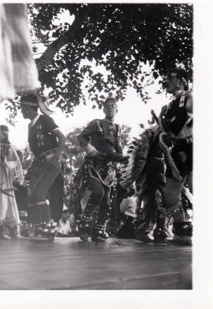 The day was still not over for us. We had bought tickets to stand and watch the chuckwagon races that evening, so we grabbed a bite to eat as walked through the midway towards the grandstand and then made our way to the rail close to the finish line of the chuckwagon races. That was a crazy contest too. Each race had four chuckwagons steered by their drivers and pulled by a team of four horses with four “outriders” racing along beside their chuckwagon; so in each race there are thirty-two horses and four chuckwagons hurtling around the racetrack that was 1,100 yards long. It was like watching Roman chariot racing on steroids.
The day was still not over for us. We had bought tickets to stand and watch the chuckwagon races that evening, so we grabbed a bite to eat as walked through the midway towards the grandstand and then made our way to the rail close to the finish line of the chuckwagon races. That was a crazy contest too. Each race had four chuckwagons steered by their drivers and pulled by a team of four horses with four “outriders” racing along beside their chuckwagon; so in each race there are thirty-two horses and four chuckwagons hurtling around the racetrack that was 1,100 yards long. It was like watching Roman chariot racing on steroids.Luckily, after the eight chuckwagon races were finished some of the spectators left the grandstand and we managed to find a couple of seats to watch the spectacular stage performance that followed the chucks . A huge tractor pulled the portable stage to where the chuckwagons had crossed their finish line and the show began. The show that year was titled “Say It With Music” and the performers certainly did. We watched Juliette, Canada’s most popular TV star of the day, the Chaine Dancers from Poland who gave us a display of both modern and folk dancing from behind the Iron Curtain, Wilf Carter, the then maestro of Western music, and the Manhattan Rockets Chorus Line. The show was followed by one of the best and longest fireworks displays we had ever seen.
Our first experience of Calgary’s Greatest Outdoor Show On Earth had been amazing, even if our feet at the end of the day were very tender!
Published on September 11, 2016 00:00
September 5, 2016
Reflections on a Spiritual Journey.
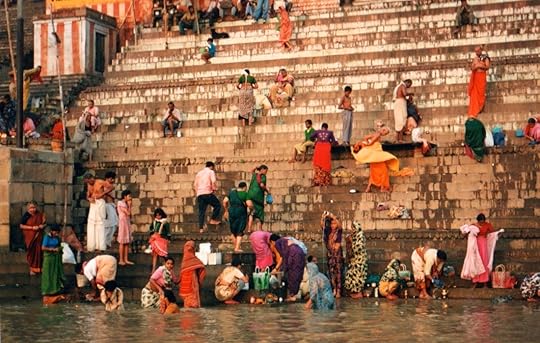
I recently published Everlasting Lies, which was about my grandparents’ journey to India. The following story tells of my own spiritual experience in India on the River Ganges.
John and I were on a tour of India, with seven other people, when we arrived late one afternoon at the city of Varanasi, on the banks of the River Ganges. The next morning we were woken at 4:45am and told to be ready to leave the hotel by 5:15 so that we could be on our boat before sunrise. It was cold and totally dark as we made our way down many steep steps to the river, along with hundreds of Hindus who were on their way to bathe and to pray.
Our old, wooden boat was about three feet wide and fifteen feet long, with a thwart in the middle for the two rowers and five other ones for us to sit on. An old, gnarled and wrinkled Indian stood silently at the stern with a long sweep that he used to steer.
As we got on our boat, a young girl sold us a leaf about the size of my hand to which a small candle had been melted. As we moved into the current, we lit our candles and gently floated them on the surface of the river as an offering to Ma Ganges. This was a form of puja, or worship, to our ancestors and at that very moment all of my ancestors who had lived in India were in my thoughts. This was my offering to the gods and to my ancestors. It was a very powerful and spiritual moment for me.
Not only were there many boats with their passengers floating their candles on the river but many bathers were doing the same thing, so hundreds and then thousands of candles flowed down the river in dozens of ribbons of light across the dark surface of the water. It was a sight of fantasy and worship that left our entire group in rapt silence and with tears in our eyes.
Then, across the river to the east, a gentle light peeked above the horizon and flooded the river and its banks with the light of a new day. As our rowers pulled on the oars against the gentle current, we could see to our right the long flights of steps and platforms that line this bank of the Ganges. These are the famous Ghats of Varanasi and, while many of them are used as swimming locations and for religious ceremonies, there are a few used exclusively for cremations of the dead. We watched from afar as families gathered around tall pyres of burning wood as the smoke and the flames engulfed their mother, father or child. After the bodies have been reduced to ashes those ashes are thrown into the river…together with the bits that didn’t burn. As we passed these burning Ghats the air was heavy with smoke and I could smell the burning wood and the incense. Lining the riverbank were tall bamboo poles on which swung baskets containing oil lamps that gave light to help the souls of the dead on their next journey.
Meanwhile, hundreds and hundreds of Varanasi’s residents were walking down the steps of “the swimming Ghats”, stripping some or all of their clothes off and, armed with soap and a toothbrush were submerging themselves into the fetid water and freshening up for their day’s work! Others were there to simply offer their morning prayers and mantras to the gods of their choice. There were also many Shamans on the steps of the Ghats. They were mostly dressed in saffron, but occasionally bright red, although many were naked and covered in the ashes of someone who had been cremated. Some, instead of being on shore, were meditating on a rock in the river. It was an extraordinary journey for me and I think that all of us were mentally exhausted by the sights, smells and sounds we had witnessed but sad when our boat pulled into the bank after our two and a half our journey.
We were then miles away from our hotel and breakfast and we had to climb up through miles of streets and alleys to get home. Along the way we were jostled and pestered by beggars, bumped by the sacred cows, whose feces was underfoot and slippery, and amazed by the dozens of Hindu shrines on street corners and in alcoves. Over breakfast all nine of us agreed that it had been a wonderful experience for each of us but was not a trip for the faint-hearted! We, however, were still in a state of euphoria and asked our guide if we could repeat the boat journey at sunset, which we did.
It was during the evening journey on the River Ganges that I had an extraordinary spiritual experience. Almost as soon as we were seated in the boat and had pulled out into the current I sensed that my ancestors, and especially my mother, were right beside me. I was calm, quiet and mentally isolated from the rest of the group, while looking east across the river to the bank way in the distance. I was thinking about my mother and wishing that she had told me stories of the first eight years of her life, which she had spent here, in India. Why had she and the rest of the family remained so silent about those years, I wondered.
Suddenly, beside me in the water was this creature, which was whitish with a long snout and swam like a dolphin. It came closer and closer to the boat until it was just a few feet away and all the time it looked straight into my eyes. My heart was pounding and I started to sweat. I was convinced that this was my mother and that she was telling me she was happy that I had made this journey to India. There was this quick moment when I was pulled into the spirit world. After a minute or two “she” disappeared below the murky water of the river. I was in shock for some time but then I grabbed a pencil and a sketchbook and drew what I had seen. I tapped our guide, Elaine, on the shoulder and told her what I had seen and she quizzed me quite hard about it, checked the field guide she was carrying and then confirmed that it was a River Ganges Dolphin; one of the rarest of all river dolphins in the world. A note in the book implied that seeing this animal was a sign of good luck. Thanks, Mum.
.
***
I would recommend a journey on the Ghats of Varanasi to anyone who has an open mind and heart.

Published on September 05, 2016 07:30
August 29, 2016
Elephants.
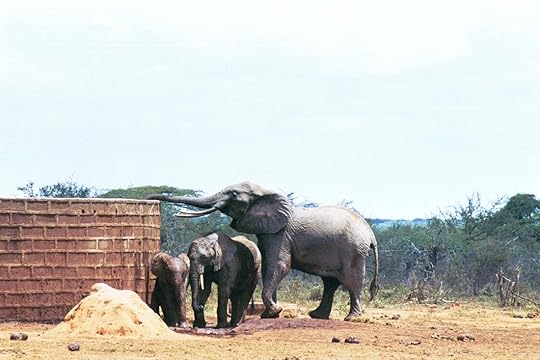
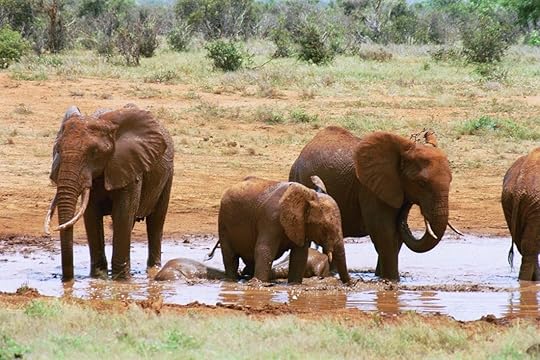 I never thought that I would fall in love with elephants but it happened on our first night.
I never thought that I would fall in love with elephants but it happened on our first night.I met them in Tsavo National Park in Kenya in 2000. My husband, John, and I had volunteered for an EarthWatch project to help with their study of patterns of elephant migration. We had spent the heat of the first afternoon in camp listening to Dr. Barbara McKnight, the biologist who was leading the field research, explain what our duties would be in the coming weeks.
She told us that the elephants moved from Tsavo East to Tsavo West and back again twice a year. During those migrations they crossed some agricultural land and caused a considerable amount of damage to the crops and to the water storage containers on the farms. Although this damage made the farmers fighting mad the government knew that thousands of tourists would spend a lot of money to see elephants. Our research project was aimed to design a wildlife management system that would balance the needs of the elephants to the well being of the farmers.
Our job as volunteers would be to identify as many elephants as we could and, as this was many years before digital photography and face-recognition software had been invented, we would be using photographic prints to track and identify individuals. We’d need to be very observant and to take accurate notes of distinguishing features. Specific tusks on an individual elephant might be broken, curved, splayed. It might have just one tusk or be tusk-less. We’d look for ears that were broken, notched, or had holes. All tails told a story; they could be twisted, have no hair or be missing the end. An elephant’s trunk could be perfect, or cut or have its tip missing. We had to look at all of the elephant’s body and look for abnormal growths or scars. Dr. McKnight kept a database of each individual elephant and updated it with our notes, photographs, locations and activity. She also tracked reproduction records like musth cycles of the males and the offspring of the females including birth date, sex and survival.
The first evening, John and I, together with Mary (another volunteer) and Chenge, our African driver and biologist, drove out to a water storage tank a couple of hours before sunset and waited for the elephants. Chenge stopped the jeep in a clearing in the bush about fifty yards from the storage tank and told us to stay perfectly still and silent for as long as it took for the elephants to come. No air moved. It was hot. We waited and waited and waited. I glanced at my watch and saw it was less than half an hour before sunset, but nothing was happening. Then they appeared and walked right beside the vehicle. These huge grey animals moved silently out of the bush, shuffled past us without a sound and headed for the water tank.
As they moved past us we could smell that earthy smell they have, look up into their black eyes and listen as they grunted, chirped and squeaked to each other. We totally forgot to try and identify any individuals as we had been asked to. We were just enthralled with being in the middle of twenty or so females and children as they drank from the tanks and stood around socializing. Suddenly, a couple of the young males became a little amorous and started trying to mount their female cousins. Then all hell broke loose as the older females chased the young males away with threshing trunks and a cacophony of trumpeting. That’s a sound and a sight that I’ll never forget
On that first night, as we had a front row seat of their evening ritual, Chenge explained to us that elephants live in two distinct groups. The females and the youngsters travel together and are led by the oldest female, the matriarch, and all mature females take an active part in raising the offspring. These groups range in size from six to more than twenty. When the young males approach puberty, at between twelve and fifteen years of age, the females push them out of the group and they will then join a band of bulls.
Elephants are complex, they like contact, often touching one another. They vocally communicate and even even purr from joy. They play, they practice mating, charging and fighting, especially the young males.
Once they have reached puberty, males are sexually active for periods of about three months. This is known as “being in musth”. Their temporal glands, which are located on each side of the head between the eye and the ear, become swollen and excrete a strong smelling fluid of rich testosterone, which runs down their cheeks. During musth the males are very aggressive and unpredictable.
One evening, we had stopped the jeep and were watching a group of elephants bathing. The larger elephants walked into the mud pool, sucked up the water in their trunks and then threw it onto their backs and underneath, onto their bellies. The teenagers of the group followed them into the pool and eventually the mothers and aunts encouraged the little ones to come in. However, they were unsteady on their feet and fell down. But the adults gently helped them scramble back on their feet.
We were all absorbed in watching this family, trying to identify and photograph them, when, suddenly across the plains came this lone massive bull in musth. As he got closer and closer we could see that his cheeks and thighs were covered with fluid. My heart was pounding as he came menacingly towards us and Chenge, our driver, decided it was time for us to leave. He turned ignition key but the engine would not start. It just sputtered and died.
Oh no! There was this majestic elephant in full musth, standing with his four feet firmly on the ground, his trunk swaying from side to side and staring at us. He was, maybe, twenty-five yards away. Chenge whispered to us that we had two options; a couple of people could get out and try to jump-start the jeep, or we could sit quietly, not move and simply watch his behaviour! We chose the second option. Chenge whispered that because the bull’s trunk that was rocking from side to side it meant he was deciding between attack and retreat. Really I thought! This swinging was becoming bigger and more frantic. But we had previously learned that this was his way of displaying a threat and the more impressive it was the less likely he was to charge. Well, that was good news! He moved at us in a sort of “mock charge” and stopped a few feet from us, which was very unnerving for us all. His ears flared, his trunk swung and now he was swinging one foot. After a minute or two he slowly turned away from our vehicle and wandered on, northwards across the plains. Chenge designated a couple of people to hop out and push the jeep to jump-start it and, much to our relief the engine coughed to life. We drove south!
That wasn't the only time we encountered an aggressive bull; it was just part of living in Kenya. What a remarkable trip this was. It gave us the opportunity to live in tents, see the sun rise on the African plains, experience elephants, lions, giraffes and other animals and to love a life of adventure and new experiences.
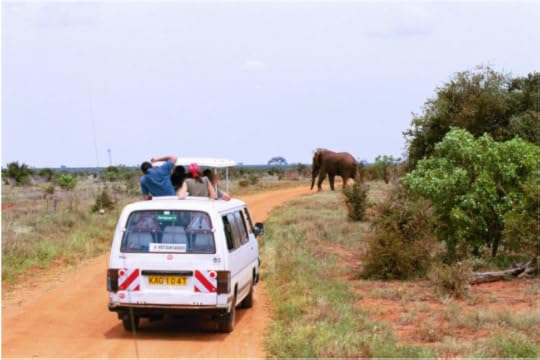
Published on August 29, 2016 09:00




